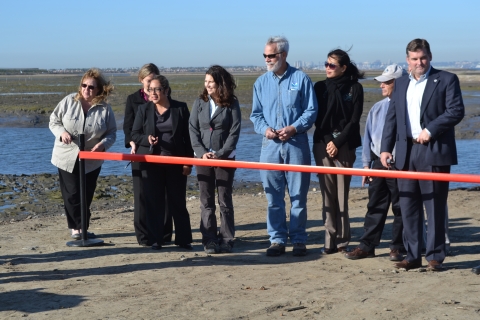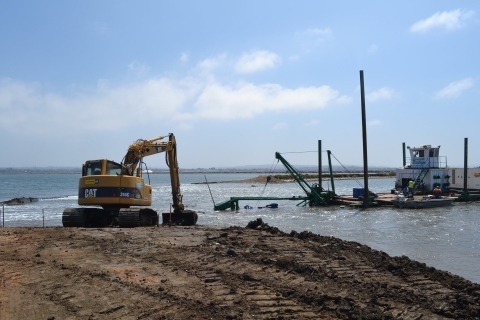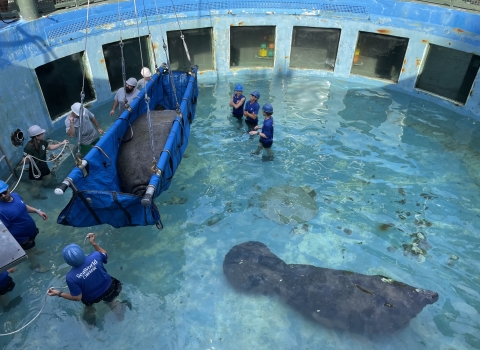Completed in the fall of 2011, the South San Diego Bay Wetlands Restoration & Enhancement Project successfully restored 220 acres of former solar salt ponds into a thriving salt marsh salt marsh
Salt marshes are found in tidal areas near the coast, where freshwater mixes with saltwater.
Learn more about salt marsh , complete with a new trail for viewing wildlife, the Bayside Birding & Walking Trail.
The project also included an additional site managed by the Port of San Diego, 80 acres at the Chula Vista Wildlife Reserve and the edge of Emory Cove.
During the construction, a floating dredge moved earth from Pond 10 into Pond 11 to create a sinuous network of channels that would serve as the main sloughs of over 200 acres of estuary in south San Diego Bay.
Now the western salt ponds have been transformed into open water, intertidal habitats, and upland marsh; thereby inviting a new and diverse array of organisms to thrive there. Once the channels were cut, and the proper elevations were achieved, the existing levees were breached in two places to connect with the Otay River channel and the bay.
These three ponds (10a, 10, and 11) hadn’t received tidal influence since 1960 or earlier. This allowed for a rebirth of an estuary, every year attracting more and more species of fish, plants, birds, and marine mammals.
On February 14, 2018, Pond 10A even attracted a wayward and non-native flamingo, and a story was run on National Geographic.
Planting, maintenance, and monitoring activities continued by research associates from the Tijuana River National Estuarine Research Reserve for five years, and finished in 2016. Monitoring activities will include topography surveys using LIDAR (Light Detection and Ranging), tidal amplitude, water quality, soil sampling, benthic macroinvertebrate surveys, fish surveys, and bird surveys. The reports of these surveys are listed here:
Post-construction Monitoring Report, Year 5 - Final Results
The results of the monitoring program proved the restored ponds were providing high-quality nursery habitat for fish and invertebrates, and natural recruitment of native vegetation including eel grass, a main food source for the eastern pacific green sea turtle.
The ultimate goal was to provide breeding habitat for a federally endangered species, the light-footed Ridgway’s rail, which proved successful in 2016. Ridgway’s rails already populated the Otay River channel. However, now that additional cordgrass has grown over the years, more captive-bred rails have been released into the marsh, producing offspring.
This $7.7 M project was made possible through a cooperative partnership between Federal, State, and local agencies, as well as several nonprofit organizations. Affectionately dubbed, "Team NaCl" or Team Salt, this group of organizations was initiated in 2008 to address water pollution and habitat loss for fish and wildlife.
Major funding was provided by:
- National Oceanic and Atmospheric Administration (NOAA) Restoration Center through the American Recovery and Reinvestment Act (ARRA) of 2009
- California Coastal Conservancy
- U.S. Fish and Wildlife Service
- Port of San Diego
- U.S. Environmental Protection Agency
The Southwest Wetlands Interpretive Association (SWIA) managed the construction contract and San Diego Audubon, Coronado Rotary Club, San Diego Oceans Foundation, and Ocean Discovery Institute all assisted with site cleanup and installation of native plants at the Port sites.
Recognition
In 2013, the restoration project as a whole received the Coastal America Partnership Award by NOAA, the highest honor endorsed by the President of the United States to recognize efforts to protect, preserve and restore America’s coastal heritage.
In 2014, the project was included in an economic return report from the U.S. Fish & Wildlife Service, called Coastal Restoration Returns for generating 130 jobs and $3.4 M into the local economy with jobs in agriculture, service, construction, and trade.
Historical Land Use of San Diego Bay:
Over the past 150 years, dredging and filling operations have resulted in the loss of 42% of San Diego Bay’s historic shallow subtidal habitat, 84% of its intertidal mudflat habitat, and 70% of its salt marsh habitat. Most of the native upland and wetland/upland transition habitat has also been lost to development.
In the future, much like this restoration project of Ponds 10 and 11, most of the remaining ponds within South Bay Salt Works will also eventually be restored.
Alternative D (Preferred Alternative) of the refuge's Comprehensive Conservation Plan contains the future goals for restoration on the refuge: Expand Habitat Management, Enhance Nesting Opportunities, Maximize Habitat Restoration, and Provide Additional Public Use Opportunities.
Under this alternative, restoration potential would be maximized: about 650 acres of salt ponds, 36 acres of new nesting habitat, 275 acres managed to benefit waterfowl and shorebird foraging and nesting, 45 acres of pond area would be managed to maintain a source of brine invertebrates within the system, and the majority of the levees would be preserved and maintained as nesting habitat for ground nesting birds.
For general questions about the restoration project, please contact
Jill Terp, Deputy Project Leader
jill_terp@fws.gov
Cell (619) 719-8579
Office (619) 221-3473





